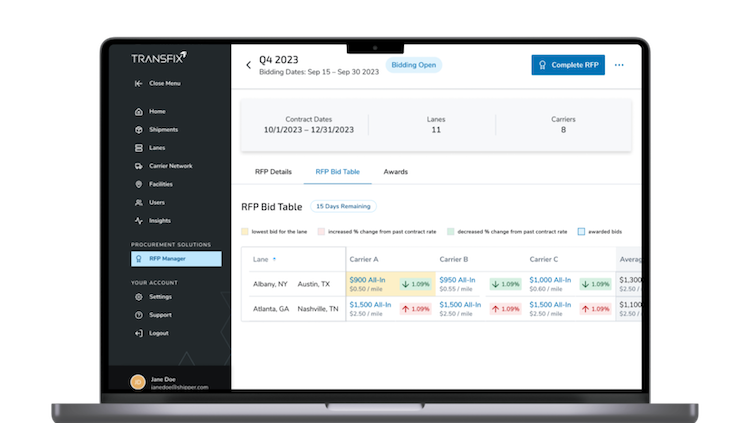In the ever-evolving transportation industry, achieving stability and consistency in your procurement practices is of paramount importance. At Transfix, we understand the challenges that our customers face in obtaining capacity while addressing their other logistics priorities. To help, Transfix has developed a guide to assist you in running an effective RFP.
This guide is not intended to be a comprehensive how-to for all shippers, but is designed to help secure true to market contract prices, at the necessary service level addressing network requirements, avoiding unforeseen delays or time-intensive and taxing repricing negotiations.
Pre-RFP Questions to Ask:
Before beginning an RFP process, it’s important to understand and prioritize goals. Some important questions to answer are:
- What service level do you need and what KPIs are you looking to track?
- How is your incumbent broker/carrier servicing this business? Are they meeting expectations?
- What are the priorities for the RFP?
- How much of your procurement teams’ time is being spent on repricing conversations and negotiations? How is this volatility affecting your organization?
- What is your current truckload freight budget? What data points were used to create your budget?
- How is your current TMS serving your business?
Best Practices for Running a Successful RFP:
-
Define Clear Objectives and Lane Requirements:
It is important to clearly outline shipping requirements, volume expectations, i.e. yearly, monthly, weekly, and service level requirements. Specify any unique requirements or equipment needs to receive accurate quotes and avoid surprises down the road. Aligning on these requirements internally will help your team communicate clearly to your service providers and improve the quality of bids received.
- Consider Shorter Contract Terms or Alternative Pricing Solutions:
Do current dynamics in the shipping market make shorter times between RFPs or alternative pricing solutions viable alternatives? If so, shorter RFP contract length, for example a quarterly bid-cycle, should better reflect current market dynamics and help minimize repricing negotiations. There are also a range of alternative pricing mechanisms available in the market, like dynamic rates, that might yield similar savings. You can find more on the best practices for contract length terms here.
- Promote Transparent Communication & Data Sharing:
Data sharing with your brokers and carriers can help them identify risks and operational complexities. Providing the most accurate volume forecasts possible will help them provide the most competitive prices. In other RFP communications throughout the bidding process, like providing feedback, bidders will always welcome details that will help them provide a competitive bid. For stop light feedback (red, yellow, green), providing information about the basis of your evaluation (for example, benchmarks) will allow for bids to land closer to targets. Opening communication will also allow your bidders to call out the operational complexities of specific lanes, giving you more insight into your network.
- Evaluate Broker/Carrier Capabilities:
Assess all aspects of the submissions received, including rates, service metrics, support levels, past experience, before making your award selection. Rates alone as the sole basis of the decision may underestimate the value of reliable performance, and hidden costs of a novice partner. Additional factors to consider include past experience, transportation capabilities, shipment visibility capability, financial health, sustainability programs, and tech capabilities. Consider contracting with a broker or carrier that can partner with you on these other priorities while balancing your budget and service needs.
- Develop Contingency Plans:
The COVID-19 pandemic saw tender rejections soar beyond 20%, resulting in increasing freight rates and capacity shortages. As the transportation market is volatile, many more typical disruptions are foreseeable, and building a contingency plan into your RFP, including splitting volume on lanes between service providers and awarding back-up providers is a prudent course of action.
- Ensure Execution: Convert Award to Routing Guide
Analysts at Gartner have found that digital procurement software can “Increase productivity for internal teams by moving away from manual transportation procurement activity.” Using the right TMS, for example, can centralize lane rate data and enable easy and efficient shipment tendering.
- Review for Continuous Improvement:
Regularly evaluate selected service providers against your established performance criteria to identify areas for improvement. You can find more on Transfix’s Carrier rating methodology here.
Unlock Tailored Insights with Transfix:
Transfix is at the forefront of revolutionizing the freight brokerage industry through our team of experienced transportation professionals, enabled by world class technology. Our platform empowers shippers to navigate the complexities of freight transportation and to obtain fair and competitive pricing. Our solutions help our customers to make informed decisions that drive efficiency and cost savings.
At Transfix, we understand that each industry has its unique shipping requirements. Our team of freight experts is here to provide you with personalized advice and insights tailored to your specific industry needs. We're here to help you maximize efficiency, minimize costs, and make informed decisions. To contact our team about running your next full-network RFP or a mini bid with Transfix, click here.
Frequently Asked Questions (FAQs)
-
How can a company effectively integrate new technology platforms recommended in the RFP process with their existing systems?
Answer: To effectively integrate new technology platforms for the RFP process, companies often need to consult with IT specialists and use API integrations. -
How does the guide suggest measuring the success of an RFP/RFQ process?
Answer: Industry-specific considerations are crucial, as each sector might have unique logistical needs and challenges, requiring tailored strategies. -
Are there any industry-specific considerations that should be taken into account when following this guide, particularly for sectors with unique logistical challenges?
Answer: Industry-specific considerations are crucial, as each sector might have unique logistical needs and challenges, requiring tailored strategies.



